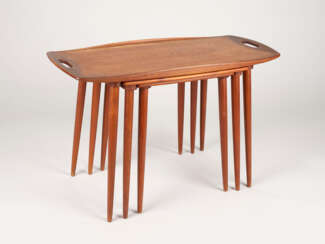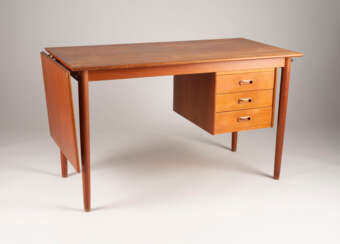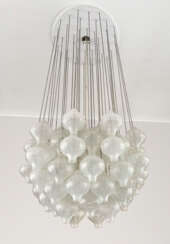
Designer furniture — 129: Modern Kunst

Josef Hoffmann, an Austrian architect and designer, is renowned for his influential contributions to early 20th-century design and architecture. As a founding member of the Vienna Secession and the Wiener Werkstätte, Josef Hoffmann's work is celebrated for its pioneering simplicity and functional elegance.
Josef Hoffmann's designs, which span furniture, decorative arts, and architecture, are distinguished by their minimalistic yet expressive style. His ability to blend aesthetics with functionality marked a significant departure from the ornate styles of the time, influencing modern design principles. Notable works include the Stoclet Palace in Brussels, a masterpiece that showcases his innovative approach to art and architecture.
His creations are preserved in prestigious museums worldwide, including the Museum of Modern Art (MoMA) and the Metropolitan Museum of Art, providing insight into his visionary approach to design. These institutions house collections of Hoffmann's furniture and decorative objects, reflecting his enduring impact on design and architecture.
For collectors and experts in art and antiques, Josef Hoffmann's work offers a study in the evolution of modern design. By subscribing to updates, enthusiasts can stay informed about exhibitions, sales, and academic research related to Josef Hoffmann, deepening their understanding of his contributions to the art and design world.

Harry Bertoia was an American artist, sculptor and furniture designer of Italian origin. He is best known for his innovative metal sculptures and iconic furniture designs.
In the 1940s and 1950s, Bertoia worked with Charles and Ray Eames in the moulded plywood division of Evans Products Company. It was at this time that he began experimenting with wire as a medium for sculpture and furniture design. The Bertoia Diamond wire mesh chair, introduced in 1952, was one of his most iconic and influential designs. Made by bending and welding wire, the chair combined aesthetic appeal with comfort and functionality.
In his sculptural work, Bertoia often created complex and abstract forms using metal rods and wire. He explored the sonic properties of his sculptures, which led to the creation of his famous 'Sounding Sculptures' series. These large-scale metal sculptures produced ethereal sounds when touched or exposed to the wind.

Max Bill, a Swiss artist, architect, painter, typeface designer, industrial designer, and graphic designer, emerged as a key figure in 20th-century art and design. Born in Winterthur, Switzerland, in 1908, Bill's education at the Bauhaus under luminaries like Wassily Kandinsky, Paul Klee, and Oskar Schlemmer profoundly influenced his multidisciplinary approach. His work spans from graphic design, where he was instrumental in shaping Swiss design from the 1950s, to product design with iconic creations like the Ulmer Hocker, a versatile stool designed in 1954.
Bill's contributions to concrete art and his role in founding the Ulm School of Design alongside Inge Aicher-Scholl and Otl Aicher in 1953, mark him as a pioneer who blurred the lines between art, design, and architecture. His theoretical writings and teaching at the Ulm School further underscored his commitment to integrating art with science, shaping a generation of designers and artists.
Noteworthy among his architectural works are his own house and studio built in Zurich-Höngg in the early 1930s and a series of public sculptures that challenge perceptions and engage public spaces in innovative ways. His legacy also includes influential roles in politics, contributions to the field of education, and the establishment of foundations to preserve his work and ideals.
Bill's extensive oeuvre, which also includes timepieces designed for Junghans and a multitude of sculptures, demonstrates his belief in the unity of form and function and the possibility of art to embody the principles of the new physics of the 20th century. His works are not only held in high regard for their aesthetic and functional qualities but also for their ability to convey complex theoretical ideas in tangible forms.
For collectors and experts in art and antiques, Max Bill remains a figure of immense importance, whose works continue to inspire and influence contemporary design and art practices. Sign up for updates related to Max Bill to stay informed about new product sales and auction events showcasing his remarkable contributions to modern art and design.

Eero Saarinen was a Finnish-American architect and industrial designer noted for his wide-ranging array of designs for buildings and monuments. Saarinen is best known for designing the General Motors Technical Center in Michigan, Dulles International Airport outside Washington, D.C., the TWA Flight Center (now TWA Hotel) in New York City, and the Gateway Arch in St. Louis, Missouri. He was the son of Finnish architect Eliel Saarinen.

George Nelson was an American industrial designer. While lead designer for the Herman Miller furniture company, Nelson and his design studio, George Nelson Associates, designed 20th-century modernist furniture. He is considered a founder of American modernist design.

Paolo Venini emerged as one of the leading figures in the production of Murano glass and an important contributor to twentieth century Italian design. He is known for having founded the eponymous Venini & C. glassworks.

Björn Wiinblad was a Danish artist and designer. He was best known for his work in ceramics, but he also worked in a variety of other media, including glass, textiles, and graphics.
Wiinblad studied at the Royal Danish Academy of Fine Arts in Copenhagen before beginning his career as a freelance artist and designer. In the 1950s, he gained international recognition for his work in ceramics, which was characterized by his use of bright colors, whimsical patterns, and intricate details.
Wiinblad's ceramic pieces were often functional, such as plates, vases, and bowls, but he also created large-scale ceramic murals and sculptures. His work was heavily influenced by fairy tales, mythology, and the arts and crafts movement.
In addition to his work in ceramics, Wiinblad also designed textiles, glassware, and furniture, and he was an accomplished graphic artist. He created illustrations for books and magazines, as well as posters, advertisements, and even a set of postage stamps for the Danish postal service.
Wiinblad's work has been exhibited in museums and galleries around the world, and he has been the recipient of numerous awards and honors for his contributions to the arts. His designs continue to be popular today, and his ceramics and other works can be found in the collections of many museums and private collectors.

Arne Vodder was a Danish architect and furniture designer. He received his art education at the Academy of Fine Arts in Copenhagen.
Arne Vodder began a very fruitful collaboration with the designer George Tanier. In this collaboration, Vodder developed some of his best designs in the late 1950s and early 1960s.





























































